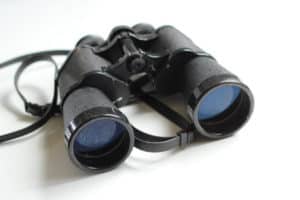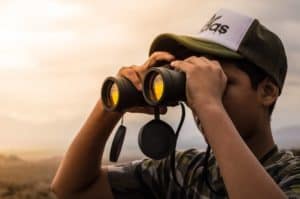When it comes to binoculars, there is no one size fits. Some binoculars are fantastic for astronomy, but not so good for bird watching.
Other binoculars are perfect for hunting game, but won’t be much use when you’re trying to count the craters on the moon.
If you don’t know your aperture from your armpit and you need some help with the technical terms, you’ve come to the right place. Read on to find out how you can pick the perfect binoculars for your needs.
Magnification
 As you’d imagine, the magnification power of a binocular refers to how much closer an object appears to you.
As you’d imagine, the magnification power of a binocular refers to how much closer an object appears to you.
For example, 10 x 35 would bring an object 10 times closer than it would appear with the naked eye.
You may be tempted to buy the binoculars with the highest magnification power, but that isn’t always a good idea. Binoculars that have a magnification of 11x or higher will amplify the movement of your hands.
Whenever your hand shakes, the whole image will shake. This can be solved with a tripod, but keep it in mind to avoid disappointment.
Size
Bigger isn’t always better when it comes to binoculars. Here’s a guide on how to choose the right size for you.
Compact
Compact binoculars come in a range of specs, but the most common ones you’ll find will be 8 x 25 to 10 x 25.
These binoculars are ideal for backpacking trips, light bird watching and quick usage, but they’re not a good choice for more detailed observation or in cases where you want to use them for a long period of time.
Simply put, compact binoculars are the right choice if you’re looking for something light-weight, easy to carry and suitable for fun, less serious use, but they’re not a good choice for advanced or specialist users who want to observe for hours on end.
Mid-Size
Mid-size binoculars range from around 7x 35 to 10 x 32. They are less light-weight and might be a bit uncomfortable if you need to hike with them.
They are, however, a good choice for watching sports, wildlife and bird watching, or other activities where you want to really get into your observation without spending a lot of money.
Full Size
Larger binoculars have a higher aperture, which means they can collect more light and give you better images in darker settings.
These binoculars are larger and heavier than the other options, so they’re not a good choice for hiking and they won’t fit in your purse.
They do, however, have a wider field of view so they’re a good choice for serious wildlife observations.
Objective Lens Diameter
The objective lens diameter means the diameter of the lens measured in millimetres. The diameter of the lenses is a good indication of how much light your binoculars can catch.
The larger the diameter, the more light can enter the binoculars and the brighter your images will appear. This is especially important at dawn, dusk and in low light situations.
Exit Pupil
 The exit pupil number is measured in millimetres and can be found by dividing the diameter of the objective lenses by the magnification number.
The exit pupil number is measured in millimetres and can be found by dividing the diameter of the objective lenses by the magnification number.
This number is used to show how bright an object will look when you observe it in darker settings. The higher the number, the brighter the image
Remember that while a larger exit pupil number is best for low lighting, it won’t be much use on a sunny day.
Relative Brightness
The relative brightness umber is found by squaring the exit pupil. It is another measure of brightness and again the higher the number, the brighter the objects.
Field Of View
The field of view lets you know how large the area that you can see through the binoculars will be. It is usually measured in feet and measures how much you will be able to see 1,000 years from where you are.
Wide fields of view are better for moving objects, such as birds or when watching sports. Higher magnification numbers often reduce the field of view which will be a problem if you want to observe multiple subjects at once, so keep that in mind when weighing up your options.
Tripod Adaptable
If you’re planning on lots of long observation sessions without much movement on your part, you may want to find a pair of binoculars that can be mounted on a tripod or, even better, comes with their own tripod.
This will take the strain off your arms, allowing you to use the binoculars for longer.
Eye Relief
The binoculars eye relief determines how far away your eye can be from the eyepiece while keeping the whole field of view in range.
Longer eye relief numbers allow you to hold the binoculars further away from your face without limiting how much you can see.
The eye relief specification is important for eyeglass wearers, because it allows them to comfortably use the binoculars without having them pressed against their glasses.
If you wear glasses, try and look for eye relief of 11mm or higher for the best results.
Focusing Wheel
Most binoculars come with a central focusing wheel which lets you control the focus of both barrels at the same time.
Many binoculars also include a dioptre adjustment ring which allows you to change the focus of one barrel to suit your individual eyesight needs.
Prisms
 Binoculars contain prisms, without which everything you saw through the binoculars would be upside down because of the way light rays enter the lenses.
Binoculars contain prisms, without which everything you saw through the binoculars would be upside down because of the way light rays enter the lenses.
- Porro prisms are bulky and tend to be cheaper, but they can provide excellent quality images.
- Roof prisms are smaller, more compact and more precise than Porro prisms, which means they tend to be a bit more expensive.
Lens Coatings
Coatings are there to reduce reflection and ensure that the optimum amount of light is captured by the binoculars. Multicoated lenses increase the amount of light and reduce the most reflection.
Fog-Proof
No one wants their binoculars to get foggy, but it can happen when they move quickly between different temperatures. Fogging doesn’t just ruin your viewing quality; it can also damage the binocular lenses.
Some binocular models use gas to reduce moisture and condensation which can protect the internal lens.
Waterproof
Waterproof binoculars often use O-rings to seal the area around the lens and protect it from moisture.
Not only will this stop water from entering the lens and damaging it, but it also seals the lenses against dust, dirt and debris so you won’t have to worry about them getting dirty.
Weather-resistant binoculars can protect against light water exposure, but they are not fully waterproof. Waterproof binoculars are designed to withstand heavy rain, but they may be more expensive.
You may want to invest in waterproof binoculars even if you’re not planning on using your binoculars in the rain, because you never know when the clouds will change.
Summary
When it comes to binoculars, there is a lot of choice. It’s best to pick a model that works best for what you’re interested in, so binoculars that are good at astronomy will be perfect for an avid star gazer but not so good for someone who wants to observe insects.
It’s a good idea to invest in water proof and fog proof binoculars as this will protect them from damage and give you peace of mind when the weather changes.
If you want to use your binoculars for a long period of time, you might want to invest in something that can be mounted on a tripod so you don’t have to physically hold the device.
It’s always worth buying something that comes with a warrantee, because you don’t want to be lumbered with something that breaks in a few months and is then basically useless.
Read more about How To Choose Binoculars? Find Out Which Ones Are Best For You! on Best Binoculars.
No comments:
Post a Comment